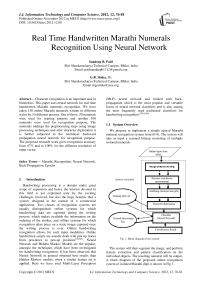Real Time Handwritten Marathi Numerals Recognition Using Neural Network
Автор: Sandeep B. Patil, G.R. Sinha
Журнал: International Journal of Information Technology and Computer Science(IJITCS) @ijitcs
Статья в выпуске: 12 Vol. 4, 2012 года.
Бесплатный доступ
Character recognition is an important task in biometrics. This paper uses neural network for real time handwritten Marathi numerals recognition. We have taken 150 online Marathi numerals written in different styles by 10 different persons. Out of these, 50 numerals were used for training purpose and another 100 numerals were used for recognition purpose. The numerals undergo the preprocessing steps using image processing techniques and after character digitization it is further subjected to the multilayer backward propagation neural network for recognition purpose. The proposed research work gives recognition accuracy from 97% and to 100% for the different resolution of input vector.
Marathi, Recognition, Neural Network, Back Propagation, Epochs
Короткий адрес: https://sciup.org/15011794
IDR: 15011794
Список литературы Real Time Handwritten Marathi Numerals Recognition Using Neural Network
- Patil S.B. and Sinha G.R, ‘Off-line mixed Devnagri numeral recognition using Artificial Neural Network, Advance in computational Research, Bioinfo journal,ISSN:0975-3273 & E-ISSN: 0975-9085, Volume 4, Issue1, 16-17 March 2012,pp. 38-41.
- Sandeep B. Patil, Dr. G.R. Sinha and Vaishali S. Patil, “Isolated Handwritten Devnagri Numerals Recogntion Using HMM”, IEEE Catalog Number: CFP1172M-PRT. EAIT in Second International conference on Emerging Applications of Information technology, Kolkota, ISBN: 978-1-4244-9683-9, pp.185-189.
- Sandeep B. Patil, G.R. Sinha and Kavita Thakur, ‘Isolated Handwritten Devnagri Character Recognition Using Fourier Descriptor and HMM’ in International Journal of Pure and Applied Sciences and Technology (IJPAST), ISSN:2229-6107, Volume 8, No 1, January 2012, pp. 69-74.
- Alain Biem, “Minimum classification Error Training for on line Handwriting Recognition”, IEEE Transaction on Pattern analysis and machine intelligence, 28(7): 1041-1051, 2006.
- Deniz Erdogmus, Oscar Fontenlu-Romeo, Jose C. Principe, “ Linear-least-squares Initialization of Multilayer Perceptrons Through Backpropogation of the desired response”, IEEE Tranaction on Neural network, 16(2): 325-337, 2005.
- Rafael C. Gonzalez and Richard E. Woods, “Digital Image Processing Using Matlab”, Pearson Education, India, 2006.
- Jarek M. Zarada, “Introduction to artificial neural system”, Jaico publishing house, 1999.
- Anil K.Jain, “Fundamentals of Digital Image processing”, PHI publication, New Delhi, 1995.
- L. Fausett, “Fundamentals of Neural Networks Architectures, Algorithms, and Applications”, Prentice Hall Publication, 2002.
- T. Fontaine and L. Shastri, "Handprinted digit recognition using spatiotemporal connectionist models," In Proceedings of the IEEE Conference on Computer Vision and Pattern Recognition, 1999.
- S. K. Parui and B. Shaw. , “Offline handwritten devanagari word recognition: An hmm based approach”, In Proc. Of PReMI-2007(Springer), LNCS-4815:528-535, December 2007.
- L. R. Rabiner, “ A tutorial on hidden markov models and selected application in speech recognition”, In Proceedings of the IEEE. 77(2):257-286, February 1989.
- Magdi A. Mohamed and Paul Gader, “‘Generalized Hidden Markov Models-Part II: Application to Handwritten Word Recognition”, IEEE Trans. On Fuzzy System, 8(1): 123-129, February 2000.
- Jia Zeng and Zhi-Qiang Liu, “‘Markov Random Field-Based Statistical Character Structure Modeling for Handwritten Chinese Character Recognition”, IEEE Trans. On Pattern analysis and Machine aintelligence, 30(5): 345-349, 2008.
- Stephan R. Veltman and Ramjee Prasad, “‘Hidden Morkov Models Applied to On-Line Handwritten Isolated Character Recognition”, IEEE Trans. On Image Processing, 3(3): 1994.
- H. Bentounsi, M. Batouche, “Incremental support vector machines for handwritten Arabic character recognition”. Proceeding of the international conference on information and communication Technologies, 2004, pp 1764-1767.


